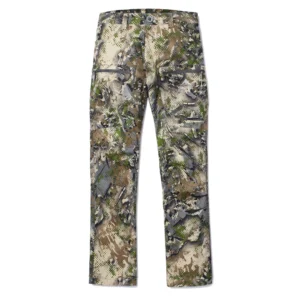Boone and Crocket was founded in 1887 by President Theodore Roosevelt as a conservation and fair chase organization, however, it was not until 1950 that they created a scoring and record keeping system for North American Big game. Remarkably, this scoring system has stood for 70 years and remains to this day mostly unchanged. Although big game records have been recorded and archived for well over 70 years the score of a trophy animal did not take hold until the 90’s. A half a century ago, when a hunter killed a big buck, it’s size was boasted about in pounds not inches of antler.
Sometime in the 60’s antlers became more of a topic of discussion in deer camps throughout the west. While there is little by way of documented timelines, if you hunted deer in the 60’s, 70’s, and 80’s the benchmark of a big muley was bagging one that boasted a 30-inch spread. I recall a recent conversation I had with a good friend and fellow mule deer aficionada about hunting big bucks in those days. He eluded to how disheartening it was to reflect on hunts where he passed some book bucks, to kill a willow horn buck that stretched the tape to 30 inches. Now make no mistake, a 30-inch buck is a rare trophy indeed.
Back in the 60’s and 70’s when Fish and Game conducted regular check stations, the number of 30-inch bucks they checked constituted a low percentage of overall bucks. When the old timers swapped stories around the campfire, the benchmark was always 30-inchs. I’m not sure why or how it happened, but sometime in the 90’s a buck’s score began to replace, the 30-inch benchmark.
PERSONAL PREFERENCE
In recent years, I have spent far more time in my good buddy, Travis Roundy’s, taxidermy shop than I care to confess. It’s especially hard to stay away from the shop during hunting season when all the great bucks are rolling in. On more than one occasion while visiting the shop, Travis would point to two different bucks and say, “which one would you shoot, if they were standing next to each other.” Without hesitation, I always chose the buck that looked the biggest. Almost without exception Travis and I agreed on what buck we would shoot.
Often the buck we chose was the buck with the lower score. I point this out, because score is only one metric, and frankly does not always reflect a buck’s true size, or a hunter’s personal preference in antler characteristics. I personally love mass and prefer it over width or tine length. Maybe you are different. Ultimately, I hope you don’t let score consume you. I have personally witnessed hunters who have taken big bucks, wore a smile of enthusiasm the size of Texas, only to have “buyers’ remorse” after the numbers were tallied.

Don’t be that hunter! Now I would be fibbing if I said it wasn’t fun to put a tape on a buck and watch the numbers ad up.
5 METRICS TO SCORE MULE DEER
If it’s your goal to put a buck in the archives of Boone and Crockett, SCI or Pope & Young read on. This article is an attempt at providing you with information to quickly and accurately field judge a big old muley. When field judging a buck there are 5 different metrics you need to be aware of: tine length, main beam, mass, inside spread and symmetry.
TINE LENGTH:
Plain and simple, tine length ads more to score than any other measurement. If

you have seconds before a big buck disappears into the thick timber, you need to quickly determine if he has exceptional tine length on every tine. If he does, hammer him. Take for example, a 190 typical buck that has 36 inches of mass with a 20 inch inside spread. Deduct his mass measurements (36 inches) and inside spread (20 inches) from his overall score (190 inches) and you get 134 (190-56=134) inches which translates into over 70% of a bucks score coming from tine length. To become adept ad field judging tine length, measure as many antlers as you can. Before you put a tape on any tine, make an educated guess and see how close you come. It won’t be long before you are a pro. This practice will translate into accuracy in the field.
MAIN BEAM:
The bulk of a buck’s score comes from the front end which means big main beams constitute a large part of the overall score. Main beams can be difficult to judge in the field. If a buck has some good width the main beam measurements will likely be close to this measurement. When measuring several of the bucks in my trophy room, I noticed a trend. Most my buck’s main beams are typically 2-3 inches larger than the inside spread. Because a mule deer’s average ear width is 20 inches you can use the ears to estimate inside spread and hence main beam length. A big buck will have long sweeping main beams that begin a second outward curl which is another characteristic you can look for.
MASS:
I wish I would not have killed a buck with so much mass said no hunter ever. Consequently, judging mass can be incredibly deceptive especially if there is snow on the ground and a buck’s antlers are wet. I recall a late season hunt in CO, where I misjudged the mass on a buck my son shot. The buck had dark antlers from rubbing in the pines and his antlers were wet from a recent storm. The snowy white backdrop amplified his mass resulting in a miscalculation. It is more difficult to determine mass on a buck with dark or wet antlers because these characteristics give the illusion of mass. Average mass on a mature buck is usually around 32-34 inches with 40 inches of mass considered above average. While mass does not typically add a lot to score, above average mass can put a buck over the top and into the books, not to mention mass looks good on any buck.
INSIDE SPREAD
While outside spread is the eye candy that gets a hunter excited, when it comes to score, inside spread is what counts. This measurement is taken from inside the main beams and is one of the simpler metrics that can be calculated in a hurry. Remember, an average mule deer ears measure tip to tip about 20-21 inches.
SYMMETRY:
Remember all those “what if” discussions with your hunting buddies after putting a big buck on the ground; what if his right side matched his left side? What if his left G2 matched his right G2. While symmetry does not add to net score, a lack of symmetry on the main frame will deduct from net score. For example, if a buck has an 85 inch right side and a 90 inch left side, you are going to end up with 5 inches in deductions. If there is anything B&C should change about their scoring system, it is deductions. They need to do away with them. Penalizing a buck for having more antler on one side than the other side is absurd. Because B&C is steeped in tradition, it is unlikely it will ever happen. Note to self. If you ever have a non-symmetrical buck with 40 inches of trash staring you down, that is a good problem to have. However, utilizing symmetry to field judge a buck quickly, can be your friend. It’s a simple calculation. If both sides are of equal proportions in length and mass, you will not need to take time to evaluate both sides. Simply add up one side, times it by two, estimate you’re inside spread and you have a good idea of what you are looking at.
If you ever have a non-symmetrical buck with 40 inches of trash staring you down, that is a good problem to have. However, utilizing symmetry to field judge a buck quickly, can be your friend. It’s a simple calculation. If both sides are of equal proportions in length and mass, you will not need to take time to evaluate both sides. Simply add up one side, times it by two, estimate you’re inside spread and you have a good idea of what you are looking at.

SUMMARY:
As mentioned earlier on in this article, one of the most effective ways to become proficient at field judging bucks is to score as many antlers as you can get your hands on. Become friends with your local taxidermist. He will likely have a lot of big bucks flowing through his shop you can practice scoring.
I know some guides and hunters who can field judge bucks quickly and with amazing accuracy. These hunters have put their hands on a lot of deer and know what a book buck looks like.
I hope this article was helpful. It was not intended to be a comprehensive article on field judging, but rather a short list of tips and tactics I have personally found useful in the field. I am neither an advocate or ambassador for B&C, P&Y, or SCI, however I’m grateful that these organizations are archiving in the annals of history many of these magnificent animals that deserve some historical and genetic recognition.
While I get a lot of satisfaction out of scoring a big buck, I have personally learned that my hunts are far more enjoyable when I put the proverbial calculator under a rock and let my eyes do the judging. And if you want to get setup with some of the best gear for your monster muley hunt, make sure to check out SKRE Gear’s Mule Deer Bundle.

